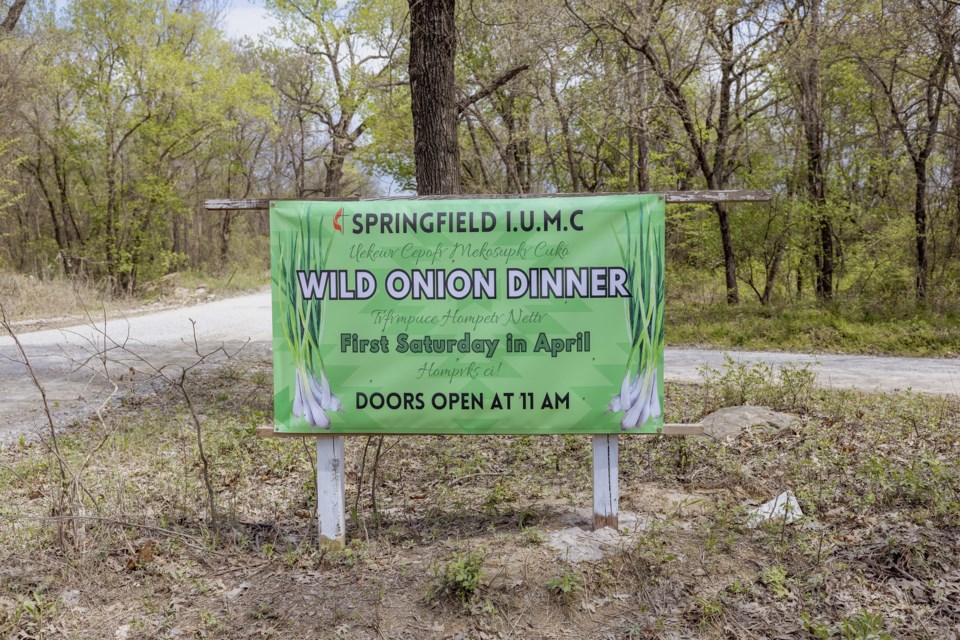OKMULGEE, Okla. (AP) — As winter fades to spring and the bright purple blossoms of the redbud trees begin to bloom, Cherokee chef Bradley James Dry knows it’s time to forage for morels as well as a staple of Native American cuisine in Oklahoma: wild green onions.
Wild onions are among the first foods to grow at the tail end of winter in the South, and generations of Indigenous people there have placed the alliums at the center of an annual communal event. From February through May, there’s a wild onion dinner every Saturday somewhere in Oklahoma.
The bright green stalks of the onions reach a few inches above the dried leaves that crunch under Dry’s feet on a crisp morning in March as he hunts through parks and empty lots near downtown Tulsa. The land he forages straddles the Muscogee Nation and the Cherokee Nation, and he’s thinking of his elisi — grandmother in Cherokee — who taught him how to pick and cook wild onions.
“Being able to cook like this, cook the things that my grandmother would cook for strangers, that’s really cool,” Dry explains as he scans the forest floor. He’s careful not to overharvest, taking only what he needs.
“Traditionally, what I grew up with, you just boil them in a little bit of water and then fry them with scrambled eggs,” Dry said.
That’s the way wild onions are typically cooked for large gatherings, a side dish of greens with a familiar peppery bite, served alongside fried pork, beans, frybread, chicken dumplings, cornbread, and safke — a soup made with cracked corn and lye from wood ash that is common among tribal nations in the southeast, including the Muscogee, Chickasaw, Choctaw, Cherokee, and Seminole.
Dry likes to mix tradition with contemporary, such as using wild onions to make omelets and kimchi.
“I’ve even used them to create salsa or chimichurri for steaks,” he said.
The following Saturday morning, at least 100 people wait for the tribal community center to open in Okmulgee, the capital of the Muscogee Nation about 40 miles (65 kilometers) south of Tulsa. For the second consecutive year, the community is gathering for a wild onion dinner to raise travel funds for Claudia McHenry, a tribal citizen hoping to compete at this year’s Miss Indian World Pageant in Albuquerque, New Mexico.
Dozens of people cook and hand out food, there is a silent auction, and a local mekko — a Muscogee spiritual leader — gives the opening welcome.
Over the last several generations, churches in Oklahoma — particularly United Methodist Churches in Native American communities — have used wild onion dinners to raise funds for church bills and annual dues, said Chebon Kernell, a mekko for his community and a UMC clergy member.
“But as the years went by, it became an enormous community event,” he said.
McHenry said seeing the community rally behind her gives her the courage she needs.
“To just see people turn out for me physically," she said. "It gives me really a lot of good emotions and pushes me and propels me to continue forward toward my goals.”
For the next three hours, hundreds show up and pay $15 for a plate of food to send her down that path. For many, helping McHenry or the local church is the only thing that could improve upon the undeniable allure of hogfry. And in no place is that truer than the Springfield UMC in Okemah, another 35 miles (55 kilometers) south, the following Saturday.
It isn’t uncommon for people to come from Arkansas, Kansas, or Texas for a piece of that community's famed fried pork and a heap of wild onions. Some travel that far because they’re part of the Muscogee diaspora. Others simply follow the church's signs down a dusty gravel road until the canopy of trees opens up to an endless field of waving grass, still copper from the winter’s rest.
For nearly two decades, hundreds have lined up on the porch of the church’s small gathering hall on the first Saturday in April for a plate of food. And every year you’ll find Carol Tiger there, elbow deep in a bowl of frybread mix.
Everyone calls Tiger the head cook.
“I just let them know what we have to do,” she said, sending a wave of laughter through the kitchen.
In past years, Tiger and other church elders would take their grandkids to pick onions, but this year they’re expecting 500 to 600 hungry people, so they purchased their onions cleaned and chopped for $40 a gallon. The families of the church also contribute a gallon each.
Elders tell stories from the rocking chairs on the porch, children play in the woods nearby, and vendors sell beadwork and clothing. The small field around the church has been cut and edged and is full of vehicles with tribal tags from across the state. Men fry pork in a giant pan over a fire outside, while women fill the dining hall with the warmth of home-cooked food.
After clearing their plates, attendees enjoy a piece of cake or a bowl of grape dumplings — a dessert traditionally made from wild grape juice that today is often made with frozen juice and canned biscuits. They stay well into the afternoon, talking and eating, certainly sad when it's time to go.
But it's mid-April, and wild onion dinner season isn't over yet. There's always next Saturday, a little further down the road.
___
Graham Lee Brewer is a member of the AP's Race and Ethnicity team.
Graham Lee Brewer, The Associated Press




